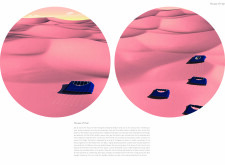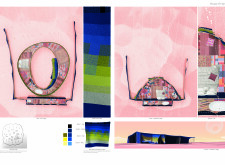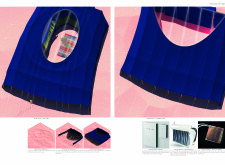5 key facts about this project
Bait al sha'ar (The House of Hair) is a modern take on traditional Bedouin tents, located in the Arabian Oryx protected area. The design aims to create portable shelters that blend historical practices with contemporary needs. The overall concept focuses on flexibility and sustainability, responding to the unique challenges posed by the desert climate.
Structure and Form
The project features V-shaped tent poles, known as 'amdán,' which resemble the horns of the Arabian Oryx. This choice in structure not only adds cultural significance but also enhances stability against strong desert winds. The arrangement of these poles creates a distinct shape that integrates naturally with the surrounding desert landscape.
Material Integration
At the core of the design is the Fala'ij, a tent textile made from goat hair dyed in dark cerulean blue. This material is rooted in Bedouin tradition and serves practical purposes. The Fala'ij includes semi-conductive materials, making it a photovoltaic surface. This allows the shelter to collect solar energy, which emphasizes the focus on sustainability in an arid environment.
Space Organization
The interior is well-organized, balancing shared spaces with areas for privacy. The Qáta, a decorative partition curtain, separates the main living area from the vast desert. This feature provides privacy while allowing residents to appreciate the surrounding landscape. The furnishings chosen for the interior enhance comfort and create a welcoming atmosphere for relaxation and socializing.
Environmental Responsiveness
ETFE (ethylene tetrafluoroethylene) is used as a sealing material in the design. This choice supports temperature control while being environmentally friendly. The lightweight and durable nature of ETFE contributes to the overall simplicity of the architecture. Its incorporation aligns with modern practices for living in the desert, ensuring comfort while maintaining an ecological focus.
The design includes a large Sama' (Sky) skylight, providing an unobstructed view of the night sky. This feature connects the indoor space with the vast desert outside, enhancing the experience for those who inhabit the House of Hair.






















































